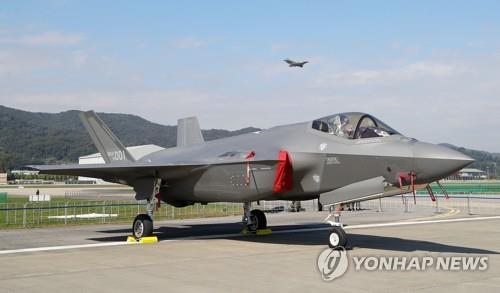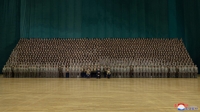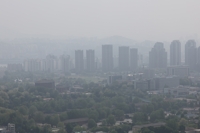(LEAD) S. Korea says F-35A emergency landing caused by bird strike, subsequent damage
(ATTN: UPDATES with F-5 crash probe result in paras 7-11, more details in 6th para; ADDS byline)
By Song Sang-ho and Kang Yoon-seung
SEOUL, March 3 (Yonhap) -- South Korea's radar-evading F-35A fighter made an emergency belly landing in January due to a bird strike that caused internal damage, its military said Thursday.
Wrapping up a weekslong probe into the incident on Jan. 4, the Air Force said a 10-kilogram eagle hit the plane's left air intake, penetrated a bulkhead into its weapons bay and caused damage to a hydraulic duct and power supply wiring that affected its navigation system and landing gear operation.
The incident occurred when the fighter was making a low-altitude flight to enter a shooting range for an air-to-ground firing mission after taking off from an air base in Cheongju, 140 kilometers south of Seoul, officials said. The pilot emerged unscathed.
Soon after the incident, South Korea and the United States formed a joint investigation team consisting of 12 South Korean experts and 14 U.S. officials from the government, the Air Force and the manufacturer of the fighter.
Investigators have looked into the fighter's flight recorder, air traffic control radar track data and statements from the pilot to verify the cause of the emergency landing.
The Air Force plans to resume the operations of its F-35A jets on Monday after weeks of suspension.
Investigators also announced results of a separate probe into a deadly KF-5E fighter crash on Jan. 11, attributing it to two small holes found in a fuel pipe.
Some fuel leaked through the holes, leading the decades-old fighter's engine to catch fire during takeoff. The pilot in his late 20s died after the jet crashed into a mountain in Hwaseong, some 40 kilometers south of Seoul.
"The holes are presumed to have been caused by corrosion," an Air Force official told reporters on condition of anonymity.
Maintenance staff apparently failed to find the holes inside the plane as they usually check the fighter with their bare eyes, the official said.
Following the crash, the Air Force checked safety conditions of all KF-5Es and their fuel pipes to prevent a recurrence, officials said. It also plans to resume the operation of KF-5Es next week.
In late January, Korea's Air Force completed the deployment of 40 F-35A radar-evading fighters. The deployment of the 40 jets was initially set for the end of last year, but it was delayed due in large part to the COVID-19 pandemic.
As a centerpiece of the country's air power, the warplane is expected to boost operational capabilities and strengthen its readiness posture against potential enemy forces, according to Air Force officers.
sshluck@yna.co.kr
colin@yna.co.kr
(END)
-
 BTS' Jungkook's 'Seven' chosen as hottest hit outside U.S.
BTS' Jungkook's 'Seven' chosen as hottest hit outside U.S. -
 From pastime to academic discipline: Exhibition spotlights evolution of Korean embroidery
From pastime to academic discipline: Exhibition spotlights evolution of Korean embroidery -
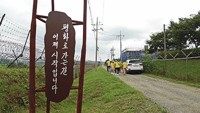 Gov't to open 10 trails near DMZ for visitors next month
Gov't to open 10 trails near DMZ for visitors next month -
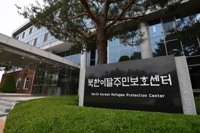 Number of N. Korean defectors entering S. Korea reaches 43 in Q1
Number of N. Korean defectors entering S. Korea reaches 43 in Q1 -
 N. Korea dismantles S. Korean building near shuttered Kaesong complex
N. Korea dismantles S. Korean building near shuttered Kaesong complex
-
 From pastime to academic discipline: Exhibition spotlights evolution of Korean embroidery
From pastime to academic discipline: Exhibition spotlights evolution of Korean embroidery -
 BTS' Jungkook's 'Seven' chosen as hottest hit outside U.S.
BTS' Jungkook's 'Seven' chosen as hottest hit outside U.S. -
 Trump suggests U.S. could withdraw its troops if S. Korea does not contribute more to support USFK: TIME
Trump suggests U.S. could withdraw its troops if S. Korea does not contribute more to support USFK: TIME -
 Number of N. Korean defectors entering S. Korea reaches 43 in Q1
Number of N. Korean defectors entering S. Korea reaches 43 in Q1 -
 (Yonhap Interview) U.S. will do 'all' it can to back S. Korea in case of China's economic coercion: official
(Yonhap Interview) U.S. will do 'all' it can to back S. Korea in case of China's economic coercion: official
-
 Indonesia proposes cutting payment for joint fighter jet project with S. Korea to one-third
Indonesia proposes cutting payment for joint fighter jet project with S. Korea to one-third -
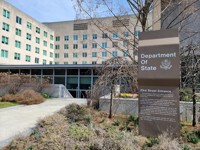 (Yonhap Interview) U.S. will do 'all' it can to back S. Korea in case of China's economic coercion: official
(Yonhap Interview) U.S. will do 'all' it can to back S. Korea in case of China's economic coercion: official -
 S. Korea's working-age population to dip nearly 10 mln by 2044 amid low births
S. Korea's working-age population to dip nearly 10 mln by 2044 amid low births -
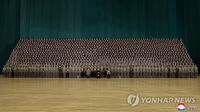 N.K. leader calls on public security officials to 'firmly defend' state unity
N.K. leader calls on public security officials to 'firmly defend' state unity -
 S. Korea to participate in U.S.-led cyber exercise this week
S. Korea to participate in U.S.-led cyber exercise this week

